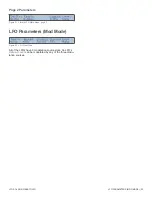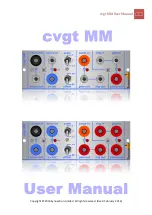
DESTINATION-BASED MODULATION
20 | MODULAR-STYLE MODULATION
Waveform
Wave Shape
Coarse
Fine
Exponential FM
Side Chain
Linear FM
-120
0
+120
-60
0
+60
-100
0
+100
0%
0
100%
Ctrl In
-100%
0
+100%
-100%
0
+100%
Ctrl In
Strength
Side Chain
-100%
0
+100%
Ctrl In
Strength
M
ultimode OSC
Pulse
Sine
Saw
Ctrl In
Ctrl In
Side Chain
-100%
0
+100%
Ctrl In
Strength
Figure 22. Solaris oscillator with 3 of 4 available modulation sources active
and “wired” to the oscillator.
Figure 22 further expands on our example by activating
three of the four available modulation sources for Osc1.
Source1
and its
Control
signal modulate the oscillator’s
wave shape. Modulation
Source2
, LFO3, is providing
exponential (Pitch) modulation of the oscillator, and LFO4
is providing the sidechain
Control
signal to modulate the
signal from LFO3. Modulation
Source3
, LpEG1 (Looping
Envelope), is modulating the
LinFM
(Linear Frequency
Modulation) parameter of the oscillator, and sidechain
modulation is coming from AT (Aftertouch).
Figure 23.
Waveform
Wave Shape
Coarse
Fine
Exponential FM
Side Chain
Linear FM
-120
0
+120
-60
0
+60
-100
0
+100
0%
0
100%
Ctrl In
-100%
0
+100%
-100%
0
+100%
Ctrl In
Strength
Side Chain
-100%
0
+100%
Ctrl In
Strength
M
ultimode OSC
Pulse
Sine
Saw
Ctrl In
Ctrl In
Side Chain
-100%
0
+100%
Ctrl In
Strength
Modulation Sources 2 and 3 modulating oscillator pitch
Figure 23 shows an example of two modulation sourc-
es modulating the same parameter. In this case, both
Source2
(LFO3) and
Source3
(LpEG1) are connected to
the oscillator’s Exponential Frequency (Pitch) input.
Finally, in all of these examples, the oscillator’s modula-
tion
Source4
slot is empty, meaning we could create even
more chaos with this oscillator by maybe adding a third
modulation source to the exponential Pitch control input, or
Dest
.
Summary of Contents for Solaris
Page 1: ...User Guide Version 1 ...
















































